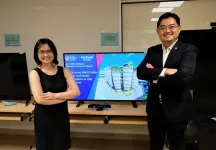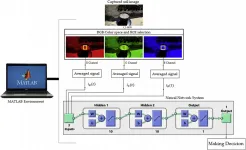Researchers enhance Alzheimer's disease classification through artificial intelligence
Better detection of the disease may lead to earlier treatment, opportunity to participate in clinical trials
2021-03-15
(Press-News.org) (Boston)-- Warning signs for Alzheimer's disease (AD) can begin in the brain years before the first symptoms appear. Spotting these clues may allow for lifestyle changes that could possibly delay the disease's destruction of the brain.
"Improving the diagnostic accuracy of Alzheimer's disease is an important clinical goal. If we are able to increase the diagnostic accuracy of the models in ways that can leverage existing data such as MRI scans, then that can be hugely beneficial," explained corresponding author Vijaya B. Kolachalama, PhD, assistant professor of medicine at Boston University School of Medicine (BUSM).
Using an advanced AI (artificial intelligence) framework based on game theory (known as generative adversarial network or GAN), Kolachalama and his team processed brain images (some low and high quality) to generate a model that was able to classify Alzheimer's disease with improved accuracy.
Quality of an MRI scan is dependent on the scanner instrument that is used. For example, a 1.5 Tesla magnet scanner has a slightly lower quality image than an image taken from a 3 Tesla magnet scanner. The magnetic strength is a key parameter associated with a specific scanner. The researchers obtained brain MR images from both 1.5 Tesla and the 3 Tesla scanners of the same subjects taken at the same time, and developed a GAN model that learned from both these images.
As the model was "learning" from the 1.5 Tesla and 3 Tesla images, it generated images that had improved quality than the 1.5 Tesla scanner, and these generated images also better predicted the Alzheimer's disease status on these individuals than what could possibly be achieved using models that are based on 1.5 Tesla images alone. "Our model essentially can take 1.5 Tesla scanner derived images and generate images that are of better quality and we can also use the derived images to better predict Alzheimer's disease than what we could possibly do using just 1.5 Tesla-based images alone," he added.
Globally, the population aged 65 and over is growing faster than all other age groups. By 2050, one in six people in the world will be over age 65. While the estimated total healthcare costs for the treatment of AD) in 2020 was estimated at $305 billion and expected to increase to more than $1 trillion as the population ages. The severe burden upon patients and their caregivers, in particular, family caregivers of AD patients face extreme hardship and distress that represents a major but often hidden burden.
According to the researchers it may be possible to generate images of enhanced quality on disease cohorts that have previously used the 1.5T scanners, and in those centers who continue to rely on 1.5T scanners. "This would allow us to reconstruct the earliest phases of AD, and build a more accurate model of predicting Alzheimer's disease status than would otherwise be possible using data from 1.5T scanners alone," said Kolachalama.
He hopes that such advanced AI methods can be put to good use so that medical imaging community can get the best out of the advances in AI. Such frameworks he believes, can be used to harmonize imaging data across multiple studies so that models can be developed and compared across different populations. This can lead to the development of better approaches to diagnosing AD.
These findings appear online in the journal Alzheimer's Research & Therapy.
INFORMATION:
Funding for this study was provided in part by the Karen Toffler Charitable Trust, National Center for Advancing Translational Sciences, National Institutes of Health (NIH), through BU-CTSI Grant (1UL1TR001430), a Scientist Development Grant (17SDG33670323) and a Strategically Focused Research Network (SFRN) Center Grant (20SFRN35460031) from the American Heart Association, and a Hariri Research Award from the Hariri Institute for Computing and Computational Science & Engineering at Boston University, Framingham Heart Study's National Heart, Lung and Blood Institute contract (N01-HC-25195; HHSN268201500001I) and NIH grants (R01-AG062109, R21-CA253498, R01-AG008122, R01-AG016495, R01AG033040, R01-AG054156 and R01-AG049810). Additional support was provided by Boston University's Affinity Research Collaboratives program and Boston University Alzheimer's Disease Center (P30-AG013846).
ELSE PRESS RELEASES FROM THIS DATE:
2021-03-15
COLUMBUS, Ohio - An analysis of historic and projected simulations from 19 global climate models shows that, because of climate change, the temperature in the Antarctic peninsula will increase by 0.5 to 1.5 degrees Celsius by 2044.
The projections also showed that precipitation - a threat to ice if it manifests as rain - will likely increase on the peninsula by about 5% to 10% over that same time period.
The estimates were published recently in the journal Climate Dynamics.
"We are concerned about these findings. We've been seeing overall quite big changes on the peninsula, generally getting warmer and ice shelves and glaciers discharging into the ocean," said David Bromwich, a leading author of the study and a research professor at The Ohio State University ...
2021-03-15
PROVIDENCE, R.I. [Brown University] -- Proposals to create a national gun registry have long been met with fierce opposition from gun rights advocates. While proponents say a registry would help in tracking guns used in crimes, opponents worry that it would compromise privacy and could be used by the federal government to confiscate firearms. Now, a team of Brown University computer scientists has devised a way of implementing a registry that may allay some of those concerns.
They propose a database that uses advanced encryption to protect privacy. The encryption scheme allows the database to be searched without being decrypted, which means people querying the database see only the records they're looking for and nothing else. Meanwhile, the system places control of data ...
2021-03-15
Lemurs can use their sense of smell to locate fruit hidden more than 50 feet away in the forest--but only when the wind blows the fruit's aroma toward them, according to a study published in the American Journal of Physical Anthropology.
"This is the first time research has demonstrated that primates can track a distant smell carried by the wind," said anthropologist Elena Cunningham, a clinical associate professor of molecular pathobiology at NYU College of Dentistry and the study's lead author.
Many animals use their sense of smell to locate food. However, less is known about whether primates can smell food that is far away, or if they instead rely on visual cues or memory to find their next meal.
Because many primates--including ring-tailed lemurs, ...
2021-03-15
CORVALLIS, Ore. - Oregon State University researchers analyzed more than 17,000 public comments focused on orca conservation in the state of Washington and found that the most common emotional sentiments were trust, anticipation and fear.
The recently published findings have important implications because they provide conservation managers a way to convert a large volume of information to a manageable amount that can help them understand why people might support or reject management actions, the researchers said.
"Emotions are intertwined in our decision-making, often playing a substantive role in public evaluations of conservation policies," said Kelly Biedenweg, an author ...
2021-03-15
(Portland - March 15) Results of a clinical study conducted by researchers in Manaus, Brazil, show that the Gazelle® Malaria test outperformed Rapid Diagnostic Tests (RDTs) and was nearly as accurate as more expensive and time-consuming expert microscopy in detecting Plasmodium vivax (P. vivax) malaria. The data was published Friday, March 12 in the Malaria Journal.
The double-blind study was based on 300 participants who sought care from Fundac?a?o de Medicina Tropical Doutor Heitor Vieira Dourado (FMT-HVD), located in Manaus, an area in the Western Brazilian Amazon, heavily endemic for P. vivax.
"Because P. vivax is not adequately detected by current tests, the infection is frequently missed, and patients don't receive essential treatment," said ...
2021-03-15
Copper nanomaterials with a cubic shape so perfect that they form neatly aligned stacks when brought together have been created by researchers at KAUST. The cuboid copper nanoclusters, developed by rational design, are a new member of an exotic nanomaterial family that has shown many promising properties but has remained very hard to make.
"Copper nanomaterials are a class of materials that exhibit useful properties for the fields of photoluminescence and catalysis," says Ren-Wu Huang, a postdoc in Osman Bakr's lab, who led the research. There is great interest in synthesizing new copper nanomaterials to understand how their structure influences their function.
Copper nanoclusters, which are of an atomically precise structure, are among the few copper nanomaterials that ...
2021-03-15
An interdisciplinary, multinational research team presents a new class of chemical compounds that can be reversibly oxidized and reduced. The compounds known as 'pyrazinacenes' are simple, stable compounds that consist of a series of connected nitrogen-containing carbon rings. They are suitable for applications in electrochemistry or synthesis, as the researchers describe in the science journal Communications Chemistry.
Redox reactions play an important role in our everyday life. In these reactions, one compound releases electrons and is oxidized, while another accepts ...
2021-03-15
A discovery by University of Queensland pain researchers may allow some future cancer patients, including children with leukaemia, to avoid their chemotherapy's worst and most debilitating side effects.
Professor Irina Vetter and Dr Hana Starobova thought "turning off" the inflammation that is one of the body's natural reactions to the chemotherapy drug vincristine might reduce its accompanying pain and unpleasant symptoms.
"We found the anti-inflammatory drug anakinra substantially reduced the awful nerve symptoms for which vincristine chemotherapy is known," Professor ...
2021-03-15
A study by a research team from Nanyang Technological University, Singapore (NTU Singapore) and China's first digital-only bank WeBank has found that security, service quality and system quality are the most important factors for customers who use mobile banking.
Two in five respondents (40%) said that the security they felt while carrying out transactions on mobile applications was their most important consideration.
This was followed by the level of service quality (25%), which referred to whether the banking applications could fulfil users' needs, such as carrying out transactions and easy access to credit card services.
System quality, which considers the performance of the application, including ...
2021-03-15
Researchers at UniSA have developed a cost-effective new technique to monitor soil moisture using a standard digital camera and machine learning technology.
The United Nations predicts that by 2050 many areas of the planet may not have enough fresh water to meet the demands of agriculture if we continue our current patterns of use.
One solution to this global dilemma is the development of more efficient irrigation, central to which is precision monitoring of soil moisture, allowing sensors to guide 'smart' irrigation systems to ensure water is applied at the optimum time and rate.
Current methods for sensing soil moisture are problematic - buried sensors are susceptible to ...
LAST 30 PRESS RELEASES:
[Press-News.org] Researchers enhance Alzheimer's disease classification through artificial intelligence
Better detection of the disease may lead to earlier treatment, opportunity to participate in clinical trials




